Ecommerce Content Marketing Principles: How Blogging Can Drive Sales and Conversions
If you’re running an online store, you’ve probably heard that blogging can boost your sales. It’s true: content marketing has helped 58% of marketers rake in more sales and revenue.
But how exactly does that work?
This article will explore the ins and outs of ecommerce content marketing, focusing on how blogging can turn browsers into buyers. You’ll find practical tips and tricks that you can start using right away to see real results.
So, whether you’re just starting out or looking to up your game, stick around. We’ll discuss proven strategies that will help you create content that attracts visitors, keeps them engaged, and convinces them to buy.
Chapters
- Ayude a los nuevos clientes a elegir su producto ideal
- Sea generoso con su experiencia
- Eduque a sus recién llegados a su nicho
- Apóyate en el contenido de estilo de vida
- Cree contenido promocional con personas influyentes relevantes
- Reutilice su contenido existente para las redes sociales
- Exponga sus clientes potenciales a su contenido por correo electrónico
- Implemente las prácticas de SEO adecuadas
- Conclusión
Help New Customers Pick Their Ideal Product

Helping newcomers choose the right product can significantly boost your ecommerce sales. This builds trust and reduces the hesitation that often comes with making a purchase.
Let’s explore two key tactics to make this happen:
Creating Comprehensive Buyer’s Guides
Buyer’s guides are an excellent way to help customers make informed decisions. They provide detailed information about your products, explaining the features, benefits, and use cases in a straightforward manner.
Here’s how to craft the ultimate buyer’s guide:
- Know who your customers are and what they’re looking for. Tailor your guide to address their specific needs and questions.
- Break down the information into easy-to-digest sections. Use bullet points, headings, and images to make the guide visually appealing.
- Cover all aspects of the product, including materials, dimensions, usability, and maintenance tips.
- Use case studies or testimonials to show how the product has benefited other customers.
Let’s look at a real-world example that nails this tactic:
Mannequin Mall, selling fashion mannequins, knocks it out of the park with their detailed buyers guide.
This guide is a treasure trove of info, helping store owners pick the perfect mannequins for their needs. It covers everything from types of mannequins to how to choose based on your store’s style.
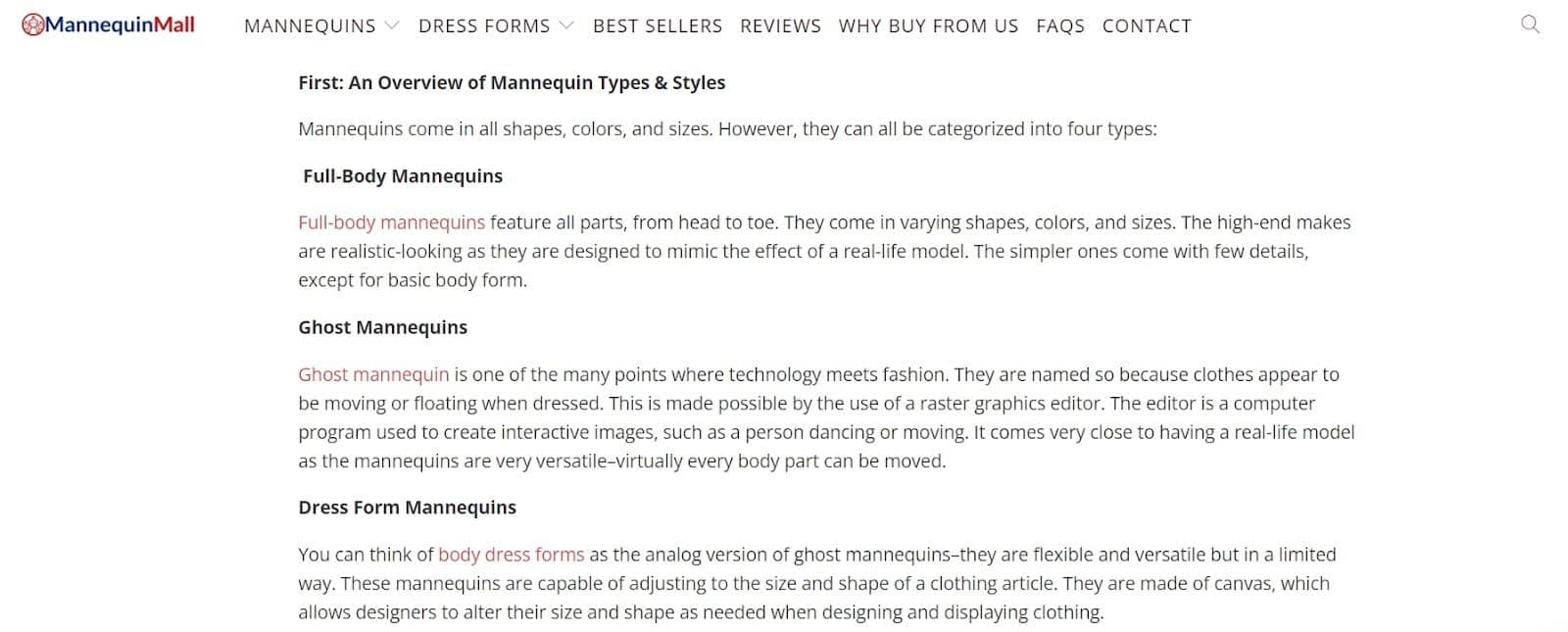
Source: mannequinmall.com
Providing In-Depth Product Reviews or Comparisons
Product reviews and comparisons can help customers understand the differences between similar products. This transparency builds confidence in their purchase decision.
Here’s how to craft effective reviews and comparisons:
- Provide a balanced view of the product, mentioning both pros and cons. Highlight unique features that set the product apart.
- Compare products based on clear and relevant criteria such as price, quality, features, and customer feedback.
- Include images or videos to give a closer look at the products.
- Add snippets of customer reviews to provide additional perspectives.
Main Clinic Supply, a company that sells medical equipment, mastered the art of in-depth product reviews and comparisons.
Their “Caire Freestyle Comfort vs. Inogen One G5” post is packed with detailed information on the two medical devices, comparing features, prices, and user experiences.
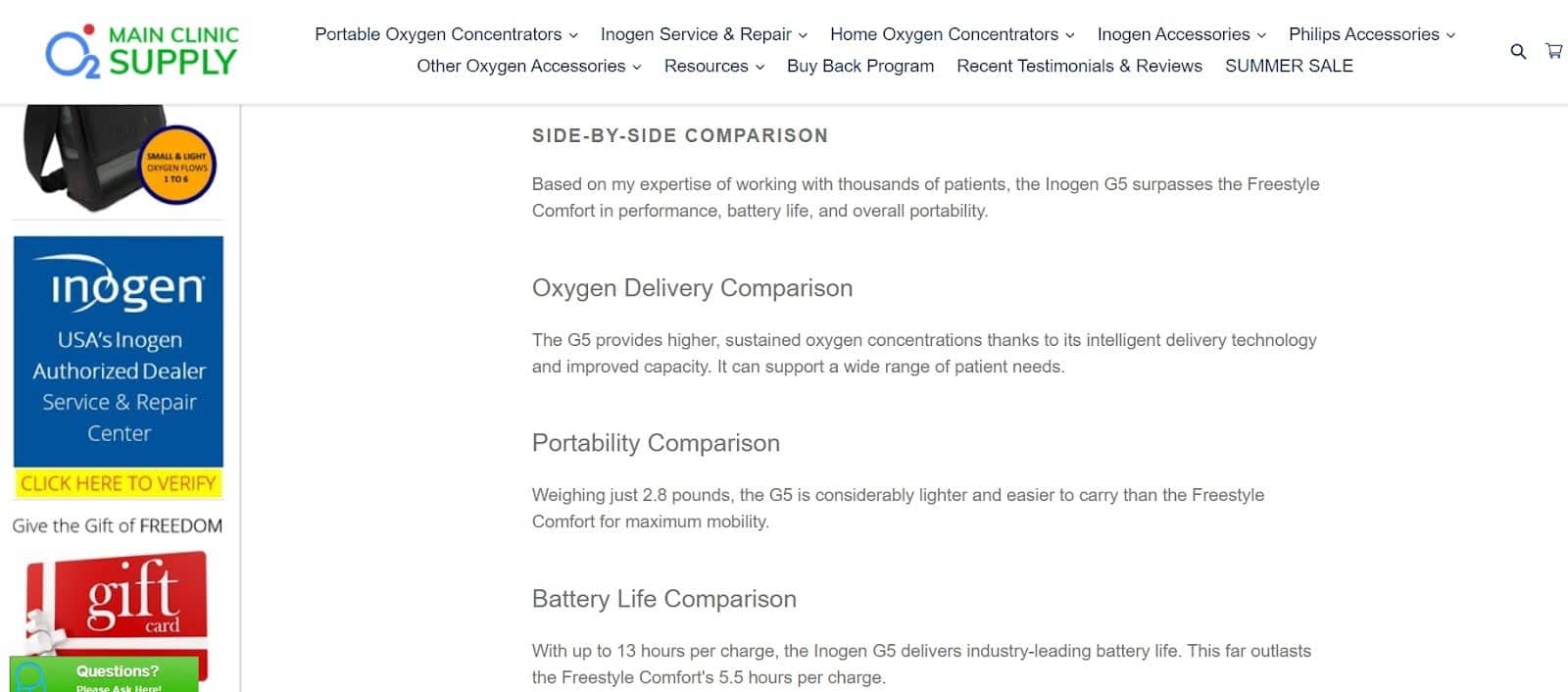
Source: mainclinicsupply.com
This approach helps medical professionals make informed decisions about vital equipment.
Be Generous with Your Expertise
Freely sharing your know-how can be a game-changer for boosting conversions and sales.
When you give away valuable info without asking for anything in return, you’re showing customers you genuinely care about their success. This builds trust, and it so happens that people buy from brands they trust.
Here’s how to be of value to your audience:
- Identify the knowledge gaps in your niche. What are the burning questions your customers have? What skills do they need to master?
- Create content that answers these questions and teaches these skills. This could be how-to guides, video tutorials, or even free online courses.
- Share insider tips, industry secrets, and pro hacks, whether you’re guiding a career in SaaS sales jobs or selling niche products. The more value you provide, the more your audience will see you as the go-to expert in your field.
- Set up a regular schedule for sharing your expertise, whether it’s weekly blog posts, monthly webinars, or daily social media tips.
A brand that’s nailing this tactic is Classical Guitar Shed, a company in the classic guitars space. They’ve created a goldmine of free resources for guitar players of all levels.
Their repository page is packed with free tutorials, practice guides, and sheet music. From beginner lessons on holding the guitar correctly to advanced techniques for seasoned players, they’ve got it all covered.
What’s impressive is how they cater to every skill level without holding anything back. They truly nurture a community of passionate musicians who see them as a trusted mentor.

Source: classicalguitarshed.com
This approach turns casual visitors into loyal fans who are more likely to choose Classical Guitar Shed when they’re ready to make a purchase.
Educate Your Newcomers to Your Niche
We’ve learned how to create content that introduces newbies to your products. Now, let’s discuss how to acquaint them with your industry as a whole.
When you help people understand your niche, you prioritize selling knowledge and confidence over selling products. By doing so, you position yourself as an expert and build long-term relationships with potential customers.
Here’s how to educate those who aren’t familiar with your niche:
- Start by identifying the basics everyone in your niche should know.
- Create a series of “101” articles or videos that break down complex topics into bite-sized, easy-to-understand pieces.
- Use simple language, plenty of examples, and even infographics to make learning fun and easy.
- Address common misconceptions or frequently asked questions.
Remember, the goal here isn’t to push products but to genuinely educate. Think about what you wished you knew when you first entered the niche. That’s the advice you want to share.
A brand that’s crushing this tactic is ShopSolar, a company that sells solar power systems. Their blog is a shining example of niche education done right. They’ve created a treasure trove of content for anyone interested in solar energy.
What sets ShopSolar apart is their knack for picking relevant topics. They put real effort into making complex solar concepts easy to grasp for the average homeowner.
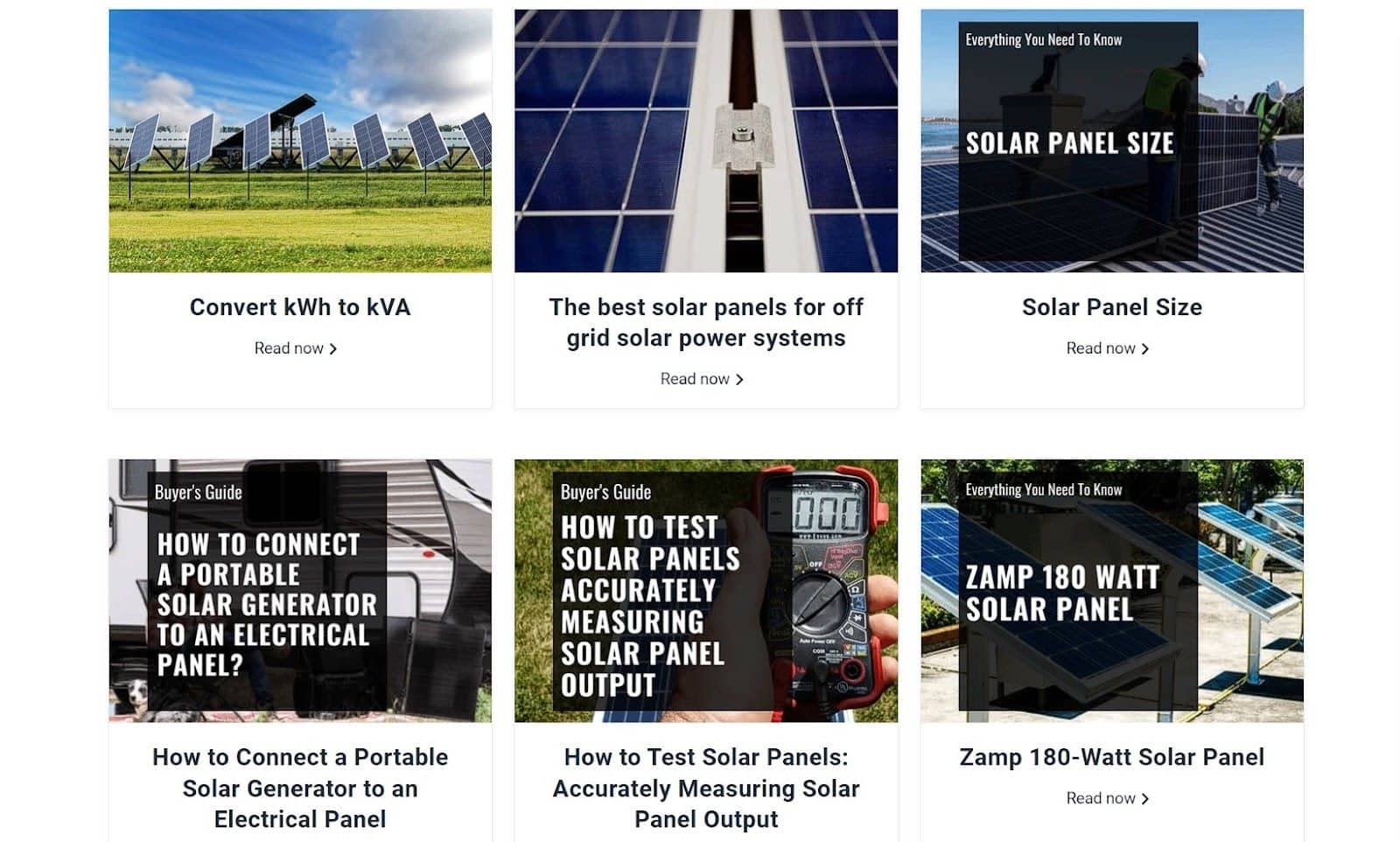
Source: shopsolarkits.com
By educating its audience like this, ShopSolar empowers people to make informed decisions about sustainable energy. That’s how you turn curious browsers into loyal customers and advocates for your brand.
Lean into Lifestyle Content
This strategy is about creating content that goes beyond your products and taps into the lifestyle your customers aspire to. It’s powerful because it helps customers see themselves as part of a community rather than just buyers of a product.
When you create content that speaks to their interests and values, you’re building an emotional connection. This connection transforms them from casual shoppers to brand loyalists.
Here’s how to create killer lifestyle content:
- Start by really getting to know your target audience. What are their interests outside of your products? What values do they hold dear?
- Create content that speaks to these aspects of their lives.
- Populate your blog with different types of content. Share stories, offer tips related to the lifestyle, or highlight events or trends in the community. The key is to make your brand feel like a natural part of your customers’ lives, not just a store they visit.
- Showcase your brand’s personality. Share behind-the-scenes content, employee stories, or your company’s involvement in the community. This humanizes your brand and makes it more relatable.
A brand that’s kicking up dust with this tactic is Chisos, a cowboy boots company. Their blog is one big celebration of the cowboy lifestyle.
Sure, they cover boot care and styles, but they also dive into the heart of Southern living. They share stories about the beauties of Texas, highlight cultural events, and even discuss raising livestock.
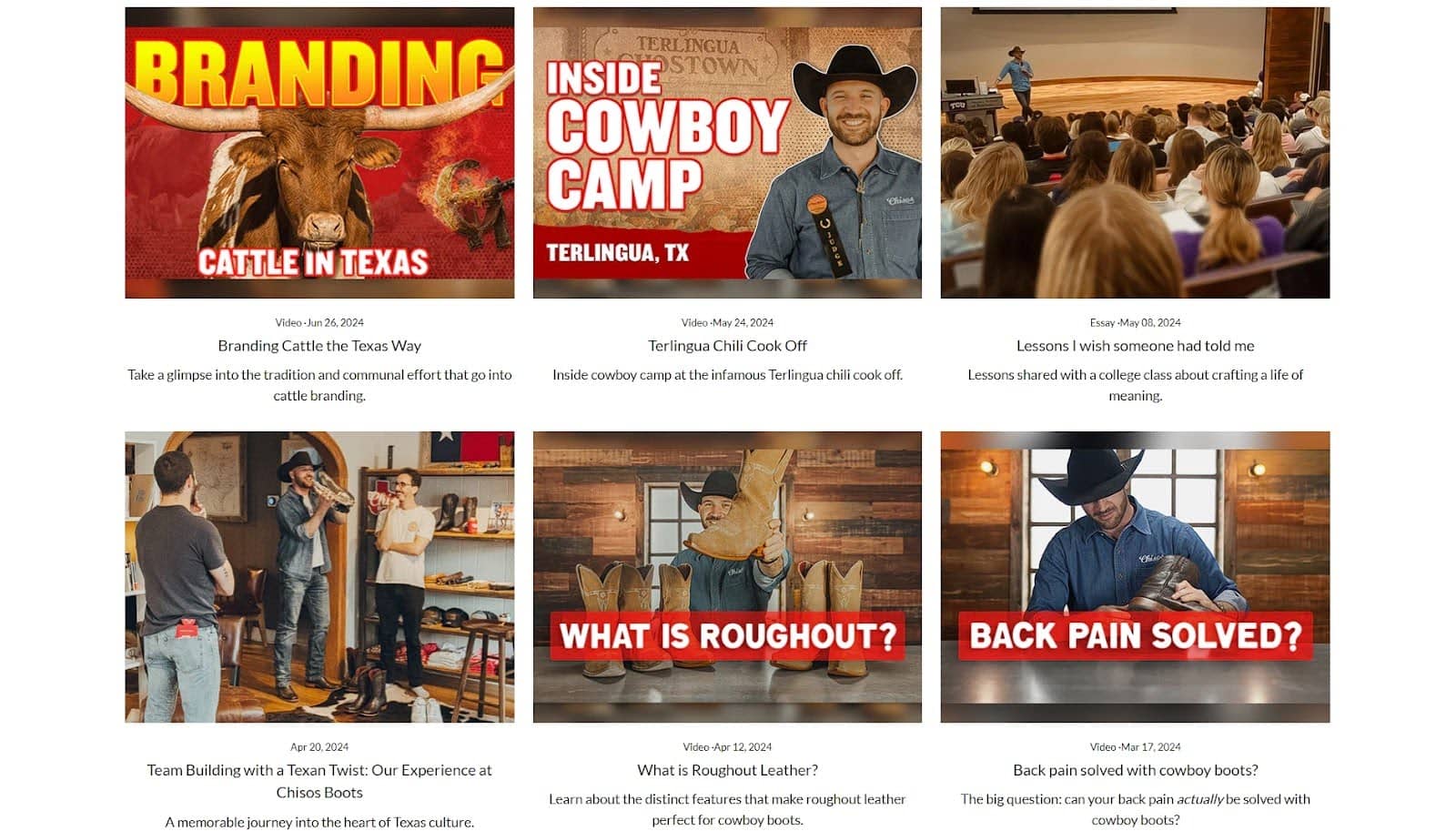
Source: chisos.com
By embracing lifestyle content, Chisos invites customers to be part of the cowboy way of life. This approach turns boot buyers into brand ambassadors who feel a real connection to Chisos and what it stands for.
Create Promotional Content with Relevant Influencers
Collaborating with influencers can dramatically boost your ecommerce business. Since 69% of consumers trust influencers, partnering with them can enhance your brand’s credibility and reach a wider audience.
Influencers bring authenticity and relatability, making your promotional content more effective. Additionally, people trust recommendations from people they admire. When an influencer talks about your product, it feels more like advice from a friend than a sales pitch.
Here’s how to team up with influential figures to up your content marketing game:
- Find influencers who align with your brand values. Look for those who genuinely connect with your target audience. Just keep in mind that bigger isn’t always better – micro-influencers often have more engaged followers.
- Work together to create content that feels authentic. Don’t just hand them a script. Let them experience your product and share their honest thoughts. This could be product reviews, how-to videos, or even day-in-the-life content featuring your product.
- Be clear about your goals, but give influencers creative freedom. Their followers trust them for their unique voice, so let that shine through.
A fantastic example of this tactic comes from Bay Alarm Medical, a brand selling medical alert systems on a subscription. They’ve taken influencer content to the next level with their “Real People. Real Testimonials.” section on their homepage.
This section links to a YouTube video that gives us a peek into a customer’s daily life. It’s a genuine look at how their product fits into someone’s routine.
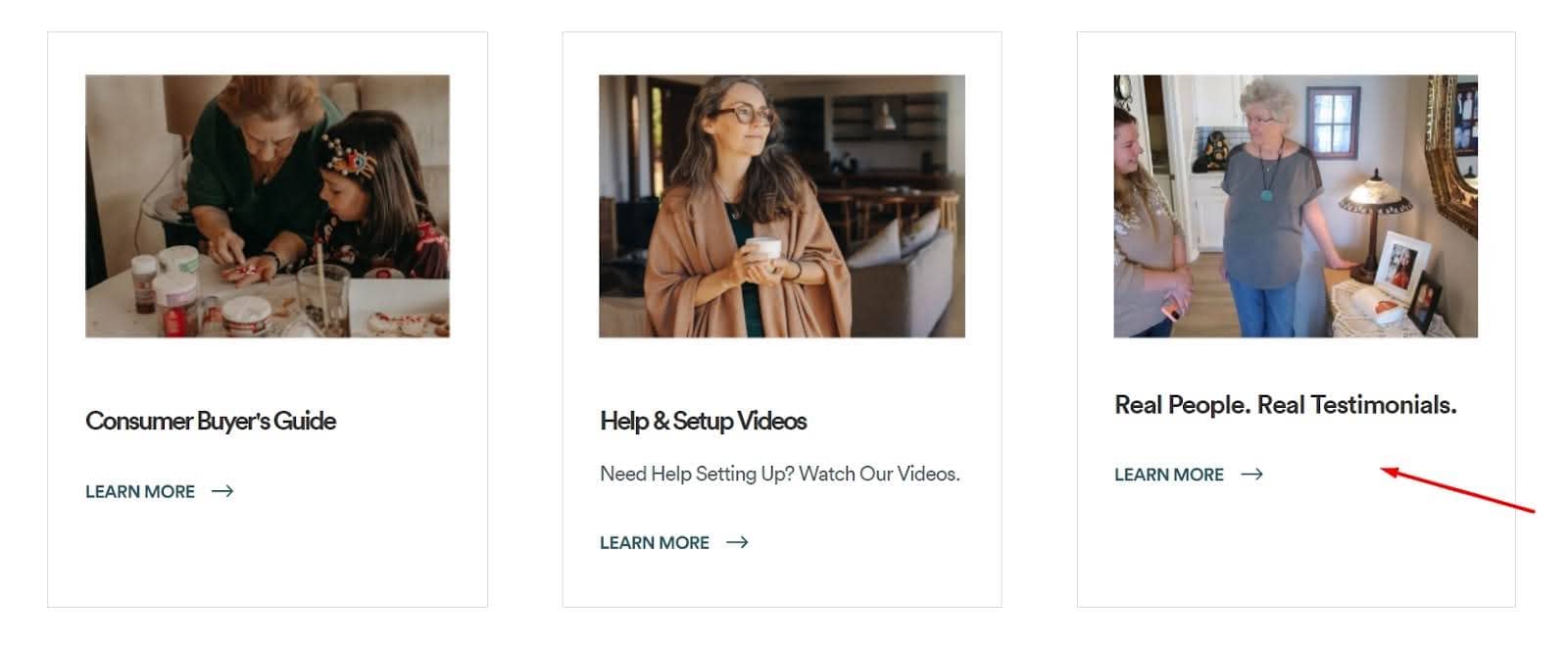
Source: bayalarmmedical.com
What makes this so effective is its authenticity. By showing a real customer using the product in their everyday life, Bay Alarm Medical gives potential buyers an unbiased look at the benefits. It’s subtle, relatable, and incredibly powerful.
Repurpose Your Existing Content for Social Media
You’ve already created a great blog that resonates with your audience. What’s left is to take your best-performing content and give it new life on social platforms.
By repurposing your content for social media, you’re extending its reach and maximizing its impact. This also saves you time and resources – no need to constantly create new content from scratch.
Here’s how to distribute your content on social media:
- First, select your top-performing blog posts, articles, or videos. Look for pieces that got lots of engagement or drove significant traffic to your site.
- Next, break these down into bite-sized pieces perfect for social media. Turn key points into eye-catching infographics. Create short video clips highlighting the main takeaways. Craft punchy quotes for Twitter or Instagram.
- Tailor your content for each platform. What works on LinkedIn might need tweaking for TikTok.
- Use a mix of formats – images, videos, carousels, stories. This keeps your feed fresh and engaging.
- Remember to add value, not just promote. Share tips, insights, or interesting facts from your content.
- Use these repurposed pieces to drive traffic back to your full content. Include clear CTAs and links where possible.
- Finally, plan a content calendar to ensure consistent posting.
Repurposing your existing content for social media is an efficient way to keep your audience engaged, attract new followers, and continue driving traffic and conversions from your best material.
Expose Your Leads to Your Content via Email
Over half of consumers buy a product directly because of an email they got. Email marketing allows you to deliver tailored content straight to your audience’s inbox, keeping them engaged and informed about your offerings.
This works because email is personal. It enables a direct line to your customers. Plus, unlike social media, you’re not competing with a noisy feed. Your message lands right in their inbox.
Here’s how to synergize your content and email marketing efforts:
- Start with a killer newsletter. Curate your best content, add some exclusive tidbits, and send it out regularly.
- Get personal. Use data to segment your list and send tailored content. New customers might need beginner guides, while long-time fans might appreciate advanced tips.
- Mix it up. Share blog posts, product updates, how-to videos, and customer stories. Keep it fresh and valuable.
- Include snippets of your content in the email itself. Tease them with enough info to click through for more.
- Use catchy subject lines. They’re your first impression, so make them count.
- Include clear CTAs. Whether it’s “Read More,” “Shop Now,” or “Watch Video,” make it easy for readers to take the next step.
- Track your results. See what content gets the most clicks and adjust your strategy accordingly.
When you consistently deliver helpful, relevant content via email, you’re building trust and nudging leads closer to a purchase.
Implement the Right SEO Practices
Content marketing is all about getting your brand visible to people actively searching for what you offer.
Optimizing for search engines the right way can bring in high-quality traffic – people who are already interested in your niche. Good SEO also keeps working for you 24/7, driving traffic long after you’ve hit publish.
Here’s how to level up your SEO game:
- Start with solid keyword research. Look for long-tail keywords that show user intent. These might have a lower search volume, but they often convert better.
- Optimize your content structure. Use clear headings (H1, H2, H3) and include your keywords naturally. But remember, write for humans first, search engines second.
- Create topic clusters. Group related content together with internal links. This shows search engines you’re an authority on the topic.
- Focus on E-E-A-T (Experience, Expertise, Authoritativeness, Trustworthiness). Back up claims with data, link to reputable sources, and showcase your expertise.
- Improve page speed, make sure your site is mobile-friendly, and use schema markup to help search engines understand your content better.
- Build quality backlinks. Create valuable, shareable content that naturally attracts links from other reputable sites.
- Keep your content fresh. Regularly update your top-performing pages to maintain their relevance and search rankings.
With these SEO practices, you can enhance your content’s visibility, attract more organic traffic, and ultimately drive more sales and conversions for your ecommerce business.
Final Thoughts
Now that you’ve got these powerful ecommerce content marketing principles under your belt, it’s time to put them into action.
We get that it can feel like a lot, but you don’t have to tackle everything at once. Start small, pick one tactic that resonates with you, and give it a shot.
Trust us, even small steps can lead to big wins. Remember, every ecommerce giant started somewhere. Just give these strategies a go and see what happens. Your next sale might be just one blog post away.
Other Interesting Articles
- AI LinkedIn Post Generator
- Gardening YouTube Video Idea Examples
- AI Agents for Gardening Companies
- Top AI Art Styles
- Pest Control YouTube Video Idea Examples
- Automotive Social Media Content Ideas
- AI Agent for Plumbing Business
- Plumber YouTube Video Idea Examples
- AI Agents for Pest Control Companies
- Electrician YouTube Video Idea Examples
- AI Agent for Electricians
- How Pest Control Companies Can Get More Leads
- AI Google Ads for Home Services
Master the Art of Video Marketing
AI-Powered Tools to Ideate, Optimize, and Amplify!
- Spark Creativity: Unleash the most effective video ideas, scripts, and engaging hooks with our AI Generators.
- Optimize Instantly: Elevate your YouTube presence by optimizing video Titles, Descriptions, and Tags in seconds.
- Amplify Your Reach: Effortlessly craft social media, email, and ad copy to maximize your video’s impact.